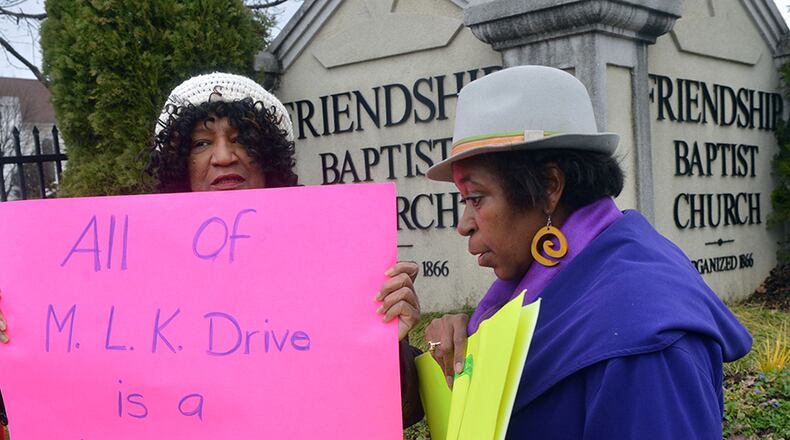A handful of neighborhood residents gathered at the intersection of Martin Luther King Jr. and Northside drives, just feet from two historic black churches that are moving to make way for the new $1.2 billion Atlanta Falcons stadium.
Holding signs that read “All of Martin Luther King Drive is a legacy,” they called for city and Falcons officials to spell out plans for rerouting the civil rights leader’s hallmark street.
With road construction now underway for the future stadium, many nearby residents are questioning traffic route proposals they fear could worsen commutes, further isolate their neighborhoods from downtown Atlanta and undermine efforts to transform Martin Luther King Jr. Drive into a grand boulevard.
So far, they’ve received few answers.
Officials from Mayor Kasim Reed’s administration and representatives from the Atlanta Falcons say they haven’t yet finalized the future layout of the corridor, a street the mayor has said he wants to transform into the premiere street in America named after the native Atlantan.
But some residents aren’t buying it.
“We want to know what the real plans are,” said John Lewis, a local historian who said his coalition of historic Westside neighborhoods will continue demonstrations in coming weeks. “Somebody knows what is going on.”
The road closures in place near the Georgia Dome are short-term detour routes, said members of Reed’s administration, who are meeting with the Falcons and state representatives on a weekly basis. Finalizing plans to realign the street could take months or longer.
In the meantime, the city council’s utilities committee has held up legislation to turn over property to state officials for construction until they receive clarity on the long-term MLK Drive plan.
“All of the plans are preliminary in nature. … No final decision has been made about a reconfiguration,” said Michael Sterling, Reed’s senior policy adviser, at this week’s Atlanta City Council meeting. “We would not make reconfiguring a street final without having a conversation with the community and city council.”
The MLK alignment issue is the latest tiff between residents, city and Falcons officials over plans to demolish the 22-year-old Georgia Dome and replace it with a retractable roof stadium.
The parties have also clashed over how to spend millions promised in community benefits to English Avenue, Vine City and Castleberry Hill neighborhoods. And the site of the future stadium itself became a mini-drama last summer as Reed won a hard-fought battle to keep it on the so-called “south site,” despite the Falcons’ strong consideration of a parcel north of the Dome.
The mayor has long said the southern location is ideal because of its proximity to two Marta stations and potential to connect to downtown amenities. To make the plan work, Friendship Baptist Church and Mount Vernon Baptist Church agreed to sell for $19.5 million and $14.5 million, respectively, to make way for the stadium.
Now, some residents worry the benefits of the south site might not be realized if a draft plan for MLK becomes reality. One proposed route released by the Falcons shows Martin Luther King Drive dead-ending into Northside, turning hopes of a grand boulevard into a zig-zagged road residents fear will exacerbate traffic headaches.
Under that proposal, drivers headed west from downtown Atlanta on MLK would swoop south to connect with Mitchell Street, dead-end at Northside, and then make a hard right on Northside, followed by a hard left to reconnect with MLK.
That, says Georgia Tech architecture professor Mike Dobbins, poses myriad problems ranging from traffic congestion to hindering economic development.
“It’s mind boggling to me. I’ve spoken to a lot of engineers whose jobs depend on some of this work and nobody who knows anything about traffic management thinks this is a good idea,” said Dobbins, the city’s former planning commissioner who has crusaded on this issue in recent months.
“You can’t have a signature boulevard that stops and somehow you find your way back to it after having waited in traffic,” he said.
Sherry Turner, executive director of the Atlanta University Center Consortium Council of Presidents, worries the proposed route will negatively impact development because traffic congestion could discourage visitors.
“We’re very supportive of the stadium proposal because of the potential to bring development to the stadium communities,” she said. “But we’re concerned that, by cutting it off, you continue to disconnect this community from downtown and other vibrant (areas).”
The city has held a handful of meetings with neighborhood planning units about these concerns, Sterling said.
“Every concern that citizens are talking about, whether it’s traffic or Martin Luther King as a grand boulevard or connectivity are at the forefront of our minds as we work in this proposal.”
Kim Shreckengost, executive vice president of Falcons parent company AMB Group, said while the zig-zag design is the working plan, “the re-route is evolving just like the stadium design is. Nothing is finalized.”
In a response to concerns from Beverly Tatum, chairwoman of Atlanta University Center group, Falcons CEO Rich McKay noted the south site is challenging because of constraints around the property.
Still, he wrote, “opening and connecting the west side neighborhoods to Centennial Park, and downtown Atlanta generally, is a priority in our stadium and site planning, whether in the form of roads, walkways, bicycle paths or other forms of access.”
For Yvonne Jones, who heads a neighborhood planning unit representing English Avenue and Vine City, much of that depends on the future alignment of MLK Drive.
“We can’t afford to lose the connections to downtown,” she said. “As they go about building a world class stadium, they need to be about developing a world class neighborhood next to it.”
About the Author
Keep Reading
The Latest
Featured


